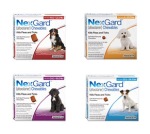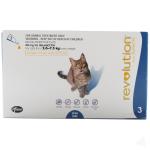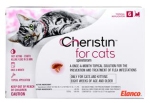By Jon Plant, DVM, DACVD
With so many products on the market to control fleas on your pet, how do you choose? Start by asking your veterinarian. They should be able to tell you about which products are most effective in your area. They will also be able to factor in the other pets in your home, how often your pet is bathed, tick exposure, and what other parasites you need to be concerned about. They’ll also take into account your pet’s age, weight, bathing routine, and medications that may interact with some products.
And a word to the wise: don’t buy the look-alike product in the big box store. Just because an active ingredient might be the same doesn’t mean they are equivalent to the real thing in every important respect. As you can imagine, the “inactive” vehicle in which the active ingredients of topical flea products spread across the skin surface is an essential part of the formula for them to be effective. This is where the generic and brand name products usually differ.
To compare some important features of the most common flea control products for dogs and cats, read on…
Bravecto®, Merck Animal Health

Route: chewable oral, with food
Frequency: every 3 months
Active ingredient: fluralaner
Time after administration to kill fleas: 88% by 4 hours, 100% by 12 hours.
Approved for: dogs only, greater than 6 months and 4 lbs.
Also controls: ticks; may control demodectic mange (off –label use).
Comments: Giving flea control products too infrequently is probably the most common reason products “fail.” Bravecto may be right for the dog owner that has trouble remembering to administer a monthly product on time. Instead, they are challenged to remember to administer something every 3 months! Hmm. Use Itchology for iPhone to set up a reminder, and you won’t have a problem in either case!
Bravecto is generally well tolerated (dogs will actually eat the chewable formulation and there is very little vomiting after administration). The speed of flea kill is good at Weeks 4 and 8, but then decreases by Week 12. However, 100% of fleas are killed within 24 hours of infestation from week 0 to week 12. These nuances may be important in a very flea allergic dog that lives in an infested environment. Where the Lone Star tick is a problem, Bravecto may need to be administered more often.
NexGard®, Merial

Route: oral soft chew
Frequency: every 1 month
Active ingredient: afoxolaner
Time after administration to kill fleas: 88% by 4 hours, 100% by 8 hours.
Approved for: dogs only, greater than 8 weeks and 4 lbs.
Also controls: ticks
Comments: In a head-to-head comparison, NexGard generally killed fleas quicker than Bravecto over the course of an 84 day study, when measured 12 hours after re-infestation. By 24 hours after re-infestation, both products killed 100% of fleas. We are so much better off quibbling about these relatively minor differences than we were 20 years ago when we were lucky to kill 50% of the fleas with much nastier chemicals! NexGard is tasty and goes down easily most of the time.
Activyl®, Merck Animal Health

Route: topical spot-on
Frequency: every 1 month
Active ingredient: Indoxacarb
Time after administration to kill fleas: 93% by 12 hours after first application; 100% by 12 hours after re-infestation on Day 7, 14, and 21; 100% by 24 hours on Day 28.
Approved for: dogs greater than 8 weeks and 4 lbs. Cats greater than 8 weeks and 2 lbs.
Also controls: Activyl Tick Plus for dogs only.
Comments: Indoxacarb itself is not effective, but it is converted into the active molecule in the gut of susceptible insects (bioactivation), whereas mammals break it down into inactive metabolites. This, together with other differences between indoxacarb’s effect on mammals and insects, gives it an excellent safety profile. Like many of the chemicals now used in flea control products, indoxacarb was first developed to control food crop pests. Activyl Tick Plus for dogs also contains permethrin and is only to be used on dogs.
Revolution, Zoetis

Route: topical spot-on, absorbed systemically
Frequency: every 1 month
Active ingredient: Selamectin
Time after administration to kill fleas: for infested dogs or cats, Revolution takes longer (24-48 hrs) to approach 100% efficacy than some other products. On the other hand, it performs well in dogs and especially cats through Day 28.
Approved for: Dogs over 6 weeks, cats over 8 weeks
Also controls: heartworm disease, ear mites, sarcoptic mange, American dog tick
Comments: The effectiveness of all monthly flea products decreases toward the end of the month. Revolution is a bit slow to start working for a heavily infested pet, but its comparative effectiveness throughout the month makes it a good choice for cats and dogs for prevention of a flea infestation (which is what we should be aiming for in any case!)
Comfortis, Elanco

Route: chew tab, with food
Frequency: every 1 month
Active ingredient: spinosad
Time after administration to kill fleas. Dogs: after dosing, 64% efficacy at 1 hour; 100% efficacy at 4 hours. The speed of kill is slower by Day 28. Cats: greater than 90% efficacy at 2 hours; 100% efficacy at 24 hours post-dosing.
Approved for: dogs greater than 14 weeks and 3.3 lbs. Cats greater than 14 weeks and 2 lbs.
Also controls: Comfortis only takes care of fleas. Trifexis® (essentially Comfortis with the additional ingredient milbemycin) also prevents and controls heartworms, hookworms, roundworms, and whipworms. Trifexis is approved for dogs (only) greater than 8 weeks and 5 lbs.
Comments: The rapid onset of action makes Comfortis or Trifexis good choices for infested pets. For flea allergy dermatitis patients, for which decreasing the chance for fleas to bite is doubly important, Comforts and Trifexis can be very helpful. The spectrum of parasites that Trifexis combats makes it an appealing product, depending on the overall parasite control program recommended by your veterinarian.
The disadvantages of Comfortis and Trifexis are (a) the relatively low palatability of the chew tabs and (b) the significant number of dogs that vomit following their initial dose. The aforementioned decrease in speed of kill during the end of the dosing cycle can also be a problem for some flea-allergic pets. Comfortis and Trifexis should not be given to dogs that are taking ivermectin as an off-label treatment for demodicosis.
Cheristin™, Elanco

Route: topical spot-on
Frequency: every 1 month
Active ingredient: spinetoram
Time after administration to kill fleas: 16% of fleas are killed by 4 hours after application; 100% effective at 12 hours. At Day 28, 97% effective at 12 hours following re-infestation.
Approved for: cats greater than 8 weeks and 2 lbs.
Also controls: fleas only.
Comments: Following the launch of Assurity, another Elanco product with a higher concentration of the spinetoram, a high incidence of hair loss due to self trauma at the application site was discovered. Assurity was subsequently withdrawn from the market and replaced with Cheristin.
Vectra®, Ceva

Route: topical spot-on
Frequency: every 1 month
Active ingredients: dinetofuran, pyriproxifen
Time after administration to kill fleas. Dogs: 96% effective in 6 hours. Cats: 98% effective in 6 hours.
Approved for: dogs greater than 7 weeks and 2.5 lbs, cats greater than 8 weeks and 2 lbs.
Also controls: Vecta 3D for dogs (with permethrin as an additional ingredient) kills ticks and repels flies and mosquitoes.
Comments: A study comparing the flea feeding activity of dogs treated with either Vectra® 3D or Comfortis® found that the speed of kill and flea bite deterrence with Vectra 3D was more rapid and sustained throughout the month.
The volume of the topical solution for the Vectra products is comparatively higher, which can put off some pet owners.
Soresto®, Bayer

Route: collar
Frequency: replace collar after 8 months
Active ingredients: imidacloprid, flumethrin
Time after administration to kill fleas. Dogs: kills existing fleas within 24 hours and re-infesting fleas with 2 hours. Cats: 98% effective in 6 hours.
Approved for: dogs 7 weeks or older; cats 10 weeks or older.
Also controls: chewing lice for one month; aids in the treatment of sarcoptic mange.
Comments: three quarters of pet owners apply monthly, spot-on flea products less than 3 times per year! With their long duration of activity, Soresto collars help protect pets throughout the year. Set a reminder to replace the collar with Itchology for iPhone.
The unique polymer structure of the collar and its modern insecticides differentiate it from the ineffective flea collars from years ago. However, the duration of effective flea and tick control is reduced to 5 months with bathing or swimming more than once monthly. It stands to reason that very frequent bathing or swimming could diminish the duration of activity even further.
Advantage II, Bayer

Route: spot-on topical
Frequency: monthly
Active ingredients: imidacloprid, pyriproxifen
Time after administration to kill fleas. 98% existing fleas within 12 hours. By day 28 in cats, only 73% of re-infested fleas were killed within 48 hours in one study. Another study shows a faster speed of kill up to 34 days after treatment.
Approved for: dogs 7 weeks or older; cats 8weeks or older.
Also controls: K9 Advantix II (with permethrin) for dogs also kills ticks and repels mosquitoes. Advantage Multi (with moxidectin) for dogs and cats also controls whipworms (dogs), hookworms, roundworms, heartworms, and ear mites (cat). An off-label use is the control of demodectic mange in dogs.
Comments: the Advantage line of products are generally very effective for flea control in most situations, when used as directed (monthly). If you wait until you see fleas on your pet (which is usually too late, no matter how good of flea picker you think you are), there is a good chance that they have had a chance to breed, lay eggs, and infest your environment. Then you are playing catch up for the next few months, instead of being preventative.
Frontline® Plus, Frontline® Tritak®, Merial

Route: spot-on topical
Frequency: monthly
Active ingredients: fipronil, (S)-methoprene, etofenprox (Tritak for cats), cyphenothrin (Tritak for dogs).
Time after administration to kill fleas. Frontline® Plus – 100% effective at 12 and 24 hours from 1 day to 28 days post treatment. Tritak® — 90% effective in 1 hour, 100% in 24 hours.
Approved for: Frontline® Plus – dogs and cats over 8 weeks. Frontline® Tritak® dogs and cats over 12 weeks.
Also controls: ticks
Comments: You’ll hear fairly frequently that Frontline “just doesn’t work any more.” Is this real, or simply a perception? Measuring genetically programmed insecticide resistance is tricky, expensive, and rarely undertaken. According to Coles and Dryden “when lack of insecticide or acaricide efficacy is noted by a veterinary practitioner or reported by the pet owner, it is essential to review the history and look for potential treatment deficiency, because the ultimate cause is much less likely to be actual flea or tick resistance.” That said, there is some innate variability in the susceptibility of various flea strains to insecticides, even among those that have not been exposed to the before.
Summary
There are a lot of effective flea products on the market. A perception that a product has not worked is more likely due to trying to stretch out the next dose beyond the manufacturer’s recommendation than anything else. Use a reminder system, like Itchology for iPhone, to keep flea prevention on schedule. Untreated pets in the household or feral animals in the environment are also common sources of treatment failure.
Speed of flea kill is an important measure of efficacy, but not all products have been evaluated in the same manner, so comparisons are imperfect. By all means learn about the products, but ask your pet’s veterinarian for their recommendation!






